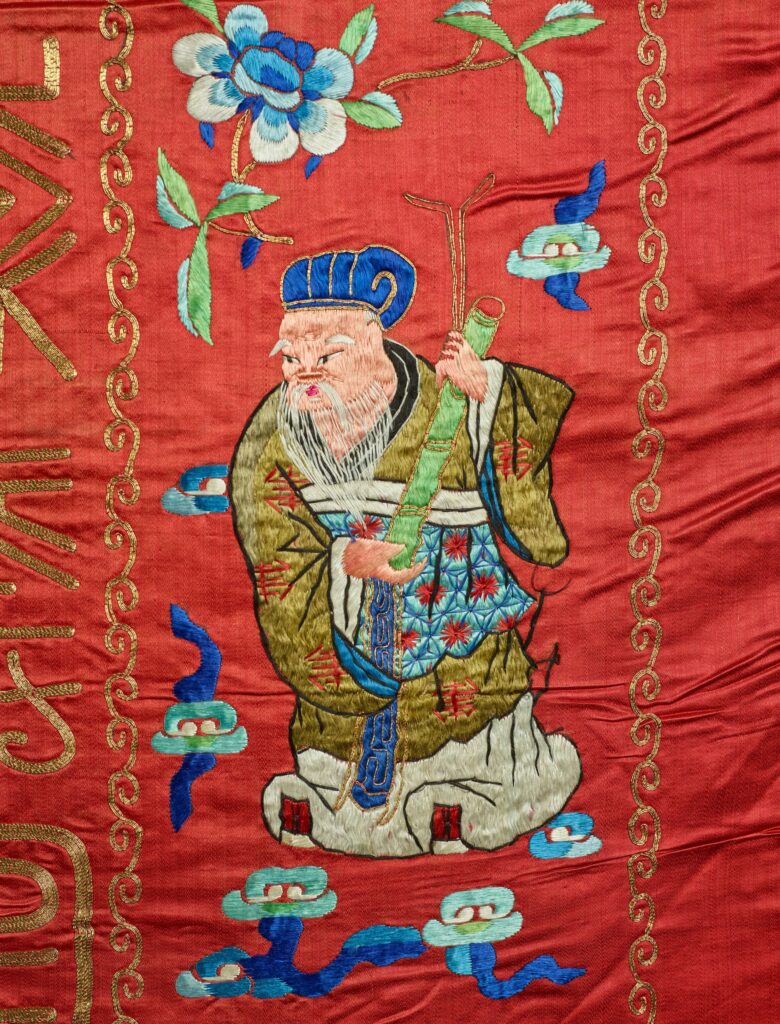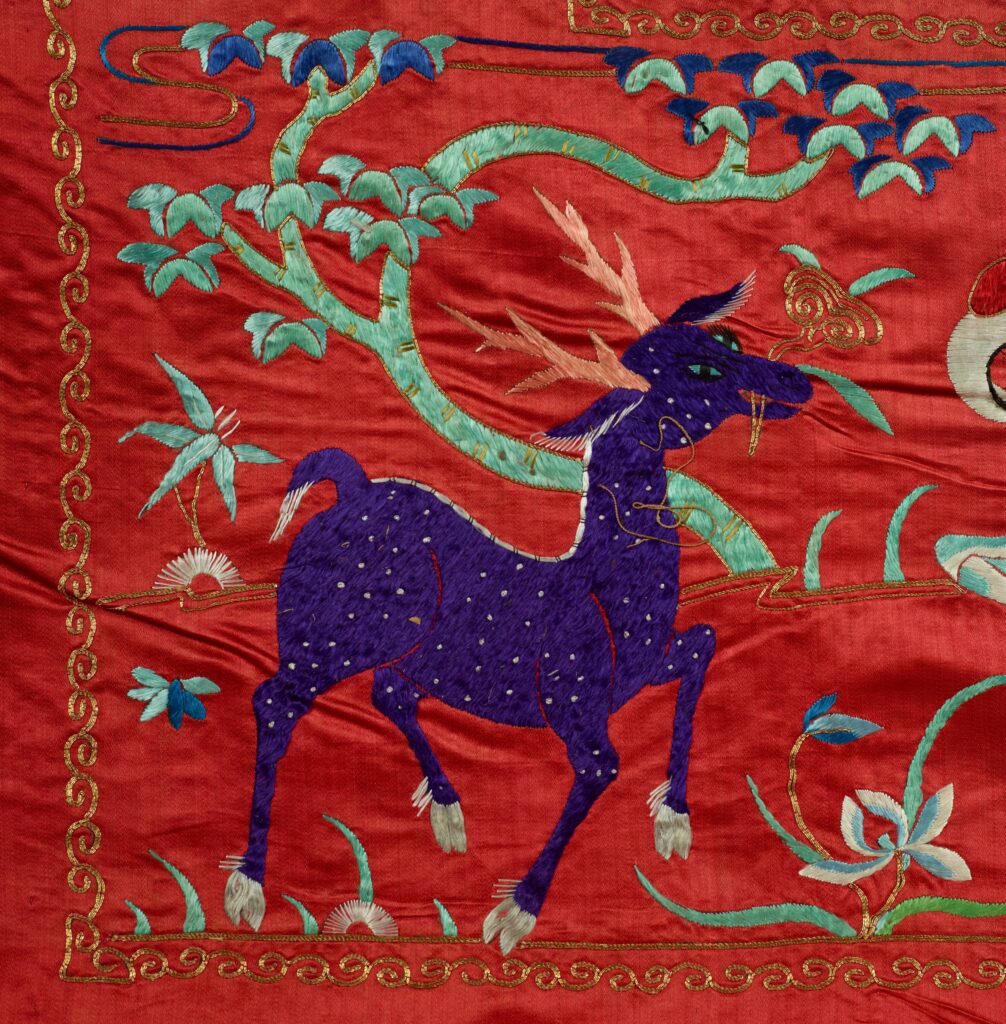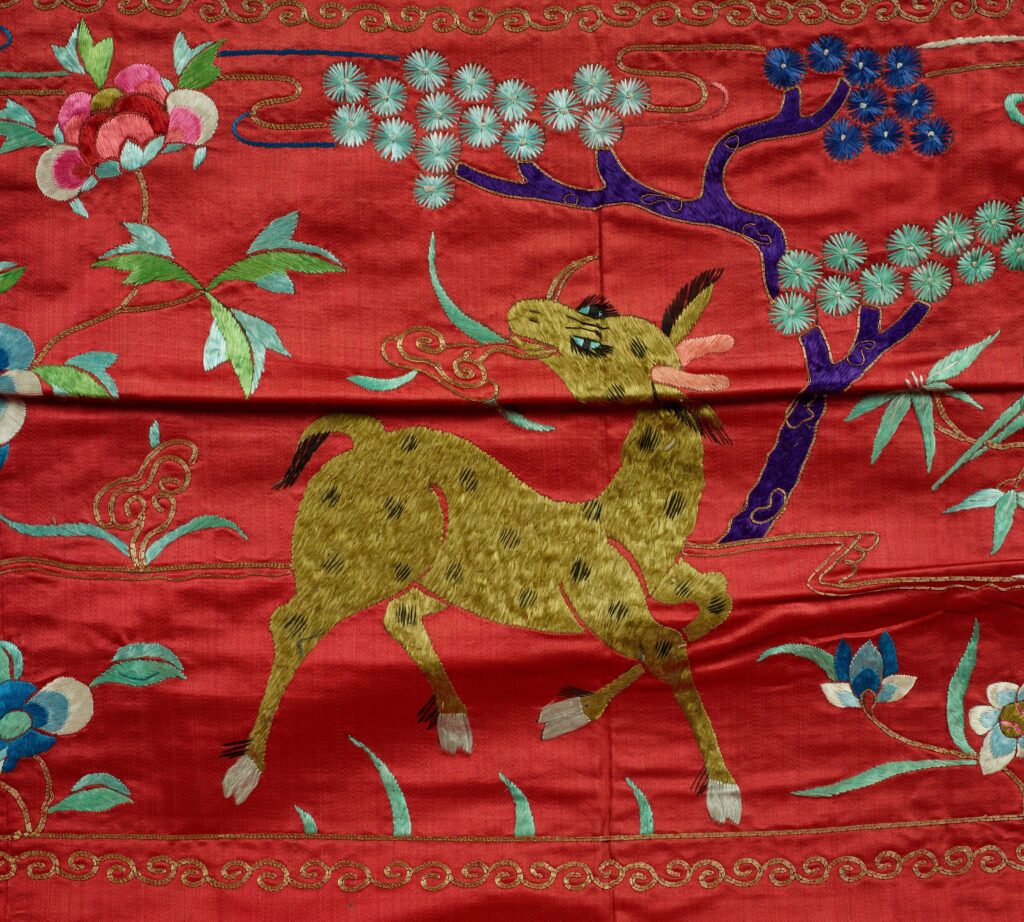What you get to see and touch when you work at a museum, especially a maritime one like The Mariners’, is incredible! Plenty of fantastic boats, navigational instruments, submarines, paintings, and more exist. However, some of the textiles in our Collection have always tickled my fancy, if you will. One in particular had me completely in awe!
Since it is Asian American Pacific Islander Heritage Month, there is no better time than the present to share its story! It is told through silk and thread, with some Chinese mythology mixed in…
In the summer of 2021, we had the opportunity to pull out our Chinese silk hand-embroidered tapestry to take some much-needed photographs for updating the catalog, among other things. When it was unrolled and hung up for a better look, there were so many “oohs,” “a-ha,” and “OMGs’’! For one, it is pretty massive. This piece measures 57-½” in width and is an impressive 113-½” in height! This beautiful piece was made from silk and has a canvas backing with canvas loops.

The cultivation of domesticated silk originated in China, and some say that the use of silk textiles dates back to as early as 6500 B.C.E. Silk is made from the cocoons of silkworms, particularly Bombyx mori, which has a lifespan of roughly six to eight weeks. The cocoon is made of a single continuous thread of raw silk, which is too fine to make into cloth, so that multiple cocoons will be used. Can you imagine that one thread could be over ⅔ of a mile long and an estimated 2,000-3,000 cocoons are required to make even one pound of silk?
Our piece is considered a tapestry because it was woven on a loom by hand and was likely dyed with either madder or vermilion to produce its red color. The threads are also made from cocoons and are colored with various dyes. One of the magnificent features of this thread is that it contains GOLD! Yes, this was tested and corroborated by one of our conservators. Another neat feature is that the pencil marks for hand embroidery in a few areas are still visible to the eye!

This piece’s figures, flowers, animals, and other symbols represent various Chinese symbolism and mythological themes. For anyone who enjoys embroidering like I do, couching, straight, outline, and satin stitches were the design stitches used on this piece. Let’s start at the top and work our way down to the bottom, shall we?
The top panel features the Sanxing. Sanxing means “three stars” and refers to the gods of longevity, wealth/status, and prosperity: Fu Xing, Lu Xing, and Shou Xing.

Shou Xing (figure on the left) is the God of Longevity and is often depicted as an older man with a white beard, robes, and a pronounced forehead with three wrinkles. He is typically shown carrying a peach, symbolizing immortality and long life. In Chinese mythology, Shou Xing is also referred to as Nanji Laoren or “Old Man of the South Pole” and is said to be the most popular. He is associated with the Canopus star of the South Pole, which is part of the constellation Carina.
Lu Xing (center figure) is the God of Wealth, and it is a common belief that he brings happiness by enhancing status through promotions and/or increased salaries. He is sometimes depicted as the sixth star of the Wen Chang Cluster, better known to many as Ursa Majoris or the Big Dipper.
Fu Xing (figure on the right) is the God of Happiness and Good Luck. He is associated with the planet Jupiter.
The center panel has 100 gold embroidered characters that may represent longevity or good fortune.

The two side panels focus on the Ba Xian (BAR SHEE YEN). Ba Xian, or The Eight Immortals, was a group of legendary beings said to have obtained immortality and represent the spectrum of Chinese society: men and women, young and old, rich or poor, civilians or military, etc. The best-known legend recounts their adventures while exploring the sea on a lotus leaf and showing the full might of their skills. Some are said to have been historical figures in Chinese history!
On the left panel from the top down:

He Xiangu (HUH SHEE YEN GOO) is the only female among the Ba Xian. She is depicted as a maiden of purity who floats on clouds and only eats mother-of-pearl and moonbeams. He Xiangu carries the lotus, a symbol of compassion and longevity. She tended to travel with Feng Huang (the Chinese phoenix), which originates from the sun and is seen as an omen of prosperity.

Lu Dongbin (LOO-DORNG-BEEN) was considered the patron of barbers and was also worshipped by those with an illness. He carried a sword and a fly-whisk. The sword was called Chan Yao kuai, the Devil-slaying saber, and was presented to him by the Fire Dragon. The fly whisk he had was called Yun Chou, the cloud sweeper. These empowered him to fly at will and to walk on the clouds as he traversed the earth, ridding the world of evil. He is also worshipped by scholars who credit him with writing “the Kong Kuo Ge,” a code of merits and demerits that guides morality. For this, he is known as the god of the Inkmakers, Lu Zu.

Cao Guojiu (TSOW-GWOR-JEE-YOO) is the patron of the theatrical profession and carries a pair of tablets resembling castanets. Said to have been the brother of Empress Cao, he is always depicted wearing imperial court dress. Legend has it that another brother’s crimes led him to seek a holy life, and the other seven immortals selected him because of his diligent pursuit and dedication.

Lan Caihe (LARN-TSWEE-HUH) could have been male or female but was often depicted as a strolling singer and flutist, patron of the indigent. Typically seen carrying a flower basket, Lan Caihe gave all the money earned to the less fortunate.

Zhangli Quan (DJORNG-LEE-CHOO-AHN) had a robust military presence characterized by a bearded face. Carrying a fan, legends say that he appears whenever a message from the heavens is ready to be conveyed to the mortal human world. He is sometimes depicted alongside a tiger, seen as a force of good and the defender against terrestrial chaos. Tigers represent strength and military prowess and are one of the four animals symbolizing power and energy. They also represented wealth and power; some legends even tell of tigers carrying heroes to the heavens.

Li Tiegua (LEE-TEE-Eh_GWI) was also known as Li of the Iron Crutch. He was considered a vital and handsome man, but one day, his soul left his body to seek wisdom from the Gods. While his soul traveled, his caretaker believed he had died and had his body cremated. With his body gone, his soul couldn’t return and entered the body of a beggar who had recently passed. Thus, he is often portrayed as an old man with a ruffly beard and messy hair held by a golden band. Depicted as a dispenser of medicine and assistance, Li Tiegua carried an iron staff or crutch and a gourd where he stored his cures.

Zhang Guolao (DJARNG-GWOR-LOW) was depicted as an elderly magician famous for his mule, which can travel great distances without rest. After a long journey, he folds up the mule and places it in his pocket. Carrying around a musical instrument, he is considered the patron of happy marriages and numerous offspring, two goals some deemed needing the help of magic.

Han Xian (HARN-SHEE-YEN) was said to have been the nephew of the great scholar and statesman Han Yu. Stories told of Han Xiang surpassing his uncle’s accomplishments and being able to predict the future. He was often seen playing the flute and carrying a basket of peaches to promote longevity.
The final bottom panel showcased various flowers, trees, animals, and a fascinating mythological creature.

Starting from left to right:

Pronounced “chee-lihn,” the qilin was a legendary hooved creature sometimes called a Chinese unicorn. Chinese mythology says that the qilin appears with the imminent arrival or passing of a sage, illustrious ruler, or someone of greatness. Legend says that one appeared just before the birth of Confucius. Across East Asia, the qilin is one of the four noble animals, along with the dragon, the Feng Huang (Chinese phoenix), and the tortoise. In this tapestry, the qilin carries Lingzhi fungus in its mouth, known as “the plant of immortality” or the divine plant.
By the way, if you love pop culture and movies, one appears in Marvel’s Shang Chi and the Ten Rings (it stopped in front of Shang Li’s car when he arrives in Tao Lo), and a baby Qilin bows to a younger Dumbledore in Fantastic Beasts and Where to Find Them: The Secrets of Dumbledore!

Typically seen in pairs, cranes are symbols of good luck and prosperity. They also symbolize old age, longevity, and immortality when depicted near or under a pine tree, as in the tapestry. There is also a bat flying above the wing of the first crane. Bats (Fu) were not feared as they represented happiness and longevity.

The final creature depicted in this panel is Chángjǐnglù, which translates to a giraffe.
However, like some textiles from our past, it needs extensive conservation work, and a little more research is still required. Despite that, it is still a stunning artifact to behold!
To view more artifacts related to Asian Americans and Pacific Islanders, please visit our website or online catalog. To view other stories about Asian Americans and Pacific Islanders, search “Asian American Pacific Islanders” on our blog page!
Sources:
Welch, Patricia Bjaaland. Chinese Art: A Guide to Motifs and Visual Imagery. Vermont: Tuttle Publishing. 2008
Williams. C.A.S. Chinese Symbolism and Art Motifs: A Comprehensive Handbook on Symbolism in Chinese Art Through the Ages with over 400 Illustrations. Vermont: Tuttle Publishing. 1974